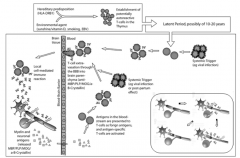![]()
![]()
![]()
Use LEFT and RIGHT arrow keys to navigate between flashcards;
Use UP and DOWN arrow keys to flip the card;
H to show hint;
A reads text to speech;
20 Cards in this Set
- Front
- Back
|
What is the pathological definition of MS? |
Inflammatory disease of the CNS characterised |
|
|
What is the clinical definition of MS? |
Objective CNS dysfunction, i.e. involvement of two or more white matter structures separated by time (1 months)*, with no other aetiology. |
|
|
What is the epidemiology of MS? |
• Age of onset - 3 rd / 4th decade (16 - 50 years) |
|
|
What are the risk factors for MS? |
• Genes
|
|
|
What is a particular genetic risk locus for MS? |
6p21 |
|
|
Which month of birth is at most risk of MS? |
May |
|
|
What are possible aetiologies of MS? |
Infection - MMR, influenza Autoimmune - MHC - HLA DRB1, association other AI, female, autoreactive T/B, pregnancy/viral effect, noninfectious |
|
|
Give the proposed MS disease model. |

|
|
|
How does MS present? |
• Motor - spasticity, weakness and gait abnormalities.
|
|
|
How are horizontal eye movements mediated? |
(Contralateral) Parapontine reticular formation -decussates-> MLF -> III nucleus -> III VI nucleus -> III |
|
|
How do you diagnose MS? |
MRI - Sensitivity = 81%
|
|
|
What is the Pulfrich effect? |
The Pulfrich effect is a psychophysical percept wherein lateral motion of an object in the |
|
|
What is Uhtoff's phenomenon? |
Temporary vision loss associated with temperature induced optic neuritis as a result of physical exercise. |
|
|
What is the role of oligoclonal IgG banding in MS diagnosis? |
Bands of IgG from serum/CSF - proteins from plasma cells. Presence in CSF with absence in serum = IgG from CNS 80-90% MS patients have this. |
|
|
What are quantitative/qualitative tests for CSF OCBS? |
Quantitative: abnormal CSF barrier function - albumin quotient, IgG quotient, increased cell count Qualitative: Agarose, acrylamide, IEF OCB |
|
|
What are the two types of MS? |
Relapse-remitting Primary progressive |
|
|
What is baclofen? |
Antispasmodic. GABA analogue, inhibits mono + polysynpatic reflexes. |
|
|
What are possible disease modifying treatments for MS? |
– Acute Relapse - high dose corticosteroids |
|
|
What symptomatic care is needed for MS? |
– Spasticity (baclofen, etc.)
|
|
|
What are good prognostic features of MS? |
– young, female
|

